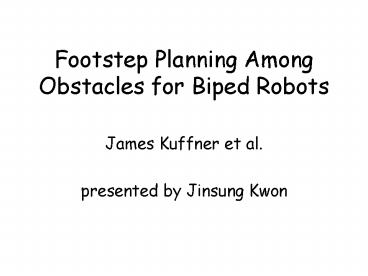Footstep Planning Among Obstacles for Biped Robots - PowerPoint PPT Presentation
1 / 16
Title:
Footstep Planning Among Obstacles for Biped Robots
Description:
Footstep Planning Among Obstacles for Biped Robots. James Kuffner et al. ... Biped Navigation Model. Statically-stable Footstep ... – PowerPoint PPT presentation
Number of Views:123
Avg rating:3.0/5.0
Title: Footstep Planning Among Obstacles for Biped Robots
1
Footstep Planning Among Obstacles for Biped Robots
- James Kuffner et al.
- presented by Jinsung Kwon
2
Objective
- Planning safe navigation strategies
- for biped robots moving in obstacle-cluttered
environments.
3
Biped Navigation ModelAssumptions
- The environment floor is flat
- Obstacles are not moving and their positions and
heights are known - Footstep positions and motions are pre-computed
- Only the floor surface is allowed for foot
placement
4
Biped Navigation ModelStatically-stable Footstep
5
Biped Navigation ModelStatically-stable Footstep
- Select placements along the edge of the reachable
region at different relative foot angles - Select a few interior placements to move in tight
areas - A few backward foot placements
- ? 15 placements for each foot
6
Biped Navigation ModelFootstep Transition
Trajectory
- Set of statically-stable motion trajectories for
transitioning between footsteps are
pre-calculated. - 15x14 210 trajectories
- needed for each foot?
7
Biped Navigation ModelFootstep Transition
Trajectory
- Statically-stable intermediate postures, Qright
and Qleft, are introduced to reduce - the number of transition trajectories.
- ? 15 for each foot
Q1 ? Qright ? Q2
8
Footstep Planning AlgorithmDynamic Programming
- Forward dynamic programming
- Greedy heuristic search instead of exhaustive
search - Priority queue of Search nodes
- (footprint placement heuristic cost)
9
Footstep Planning AlgorithmDynamic Programming
- Fail
- if No more valid successor nodes
- if number of nodes in search tree exceeds
pre-defined maximum limit
Obstacle Collision
10
Footstep Planning AlgorithmCost Heuristic
Function
- D(NQ) depth of NQ in the tree
- ?(NQ) penalty to orientation change or
- backward step
- ?(NQ) min steps to traverse the straight-
- line distance to the center of the
goal - region
- w weighting values
- ? The heuristics favors straight path with less
steps to the goal.
11
Footstep Planning AlgorithmObstacle
Collision-checking
- Two-level collision checking
- 1. 2D polygon-polygon intersection test
- Outline of obstacle projection
- ?? Outline of footstep
- 2. 3D polyhedral minimum distance
- Check for footstep and trajectories
12
Footstep Planning AlgorithmObstacle
Collision-checking
- Lazy-evaluation
- Insert all successors and perform the
minimum distance calculation after a node is
removed from the priority queue - ? Reduce the num of collision check which is
very expensive in calculation
13
Footstep Planning AlgorithmOverview of Planner
14
Experiments
- 15 footsteps
- 20 floor obstacles
- 6,700 nodes in the search tree
- ? Computed in 12 sec on 800MHz Pentium II
- wd 1.0
- wp 0.2
- wg 1.0
- determined experimentally
15
Experiments
16
Future works
- 1. Step upon the surface of obstacles
- 2. Handle environments with uneven
- terrain
- 3. Incorporate visual or sensor
- feedback during planning
- 4. Investigate different heuristics
- 5. Running on a real humanoid
- 6. Include dynamic stepping motions































